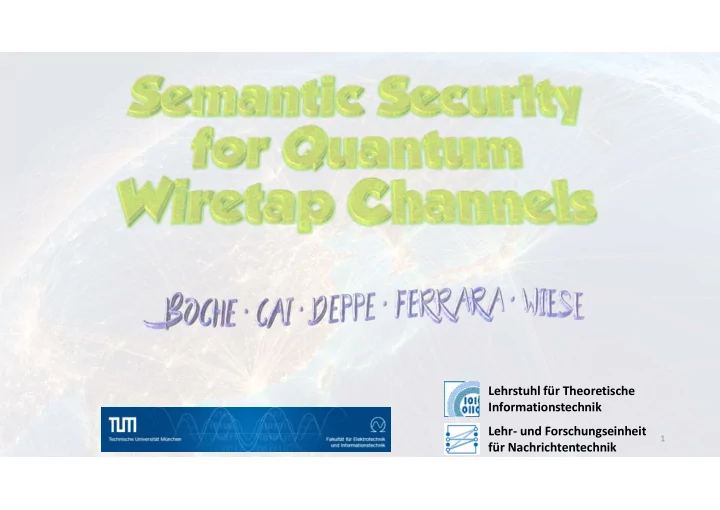

Lehrstuhl für Theoretische Informationstechnik Lehr- und Forschungseinheit 1 für Nachrichtentechnik
Let H and 𝐼 � be finite-dimensional complex Hilbert spaces. We consider the channels W: A → S(H) V: A → S ( 𝐼 � ) (W,V) is called a classical-quantum wiretap channel W represents the communication link to the legitimate receiver V‘s output is under control of the wiretapper 2
3
4
5
6
For classical-quantum channel V, probability distribution P, and quantum states σ and ρ such that supp (ρ) ⊂ supp (σ) S ( σ ) ≔ -tr( σ log σ ) χ (P;V) ≔ 𝑇 ∑ − ∑ 𝑄 𝑦 𝑊 𝑦 𝑄 𝑦 𝑇 𝑊 𝑦 �∈� �∈� D ( σ‖ρ ) ≔ tr ( σ log σ − log ρ ) D � ( σ‖ρ ) ≔ log tr( σ � ρ �� ) 7
The strong secrecy capacity of (W,V) is equal to the maximum is taken over finite input sets M, input probability distributions P on M, and classical channels E : M → P( 𝑌 � ). 8
The semantic secrecy capacity of (W,V) is equal to its strong secrecy capacity 9
10
This is only an existence statement How to choose the semantically secure message subsets 11
messages �� �� seeds �� �� Idea: biregular irreducible functions (BRI functions) Similar to universal hash functions for strong secrecy The channel users share a random seed 12
Let S, X, N be finite sets. A function f : S × X → N is called X biregular irreducible (BRI) if there exists a subset M of N such that for every m ∈ M we have S 𝑒 � = 4 , 𝑒 � = 4 13
The modular BRI scheme : ��� (m) (E,D) is a transmission code for W and f is a BRI function. 𝑔 denotes the random choice of a preimage of f given seed s and message m. 14
ϵ-subnormalized classical-quantum channel V ′ : For all x V ′(x) ≥ 0 1 − ϵ ≤ tr V ′(x) ≤ 1, 15
For ϵ-subnormalized V’≤ V and random variable M independent of S , it holds where λ � (f,m) is the second largest singular value of 𝑄 �,� 16
� Define V( X ) := . For M independent of S |�| ∑ V(𝑦) � For ϵ-subnormalized V’≤ V and fixed m For ϵ-subnormalized V’≤ V and fixed m 17
For ϵ-subnormalized V’ and fixed m 18
For any probability distribution P over X, there exist BRI modular codes achieving the semantic secrecy rate χ(P;W) − χ (P;V) using transmission codes achieving the transmission rate χ(P;W). 19
transmission codes achieving the transmission rate χ (P;W) with P-typical codewords 𝑦 � , there is a V′ such that rank[V′(𝑌 � )] max � � ∈ � � V′(𝑦 � ) � ≤ 2n(χ(P,V)+δ) Choose |S| ≥ 2−n(χ(P,V)+ α ), |M| ≤ 2−n(χ (P;W) − χ(P,V)+ β ) λ � (f,m) ≤ 2−n(χ(P,V)+2δ) 20
The semantic secrecy capacity of (W,V) is equal to its strong secrecy capacity, and can be achieved using transmission codes for W 21
public code BRI modular code seed message [01100...|110100110000101100111......] 22
23
24
Beware of eavesdropper #StaySafe
Recommend
More recommend